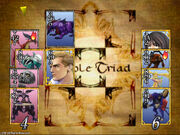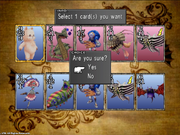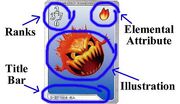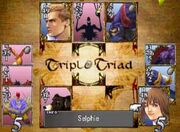Template:Sideicon

A game of Triple Triad.

The winner gets to choose a card or more from the loser.
The cards originated when a psychic named Orlan modified these tarot cards for games. The game became popular with soldiers passing time between battles. As its popularity spread, each region developed its own rules and picture variations.
Tutorial - FFVIII Info Corner
Triple Triad (トリプルトライアード, Toripuru Toraiādo?) is a popular card game in Final Fantasy VIII. Conceived by battle system designer Hiroyuki Ito, Triple Triad is simply a sidequest and is not needed in order to finish the game's story; however, the cards can be refined into items using Quezacotl's Card Mod ability. Many of the game's rarer items are most easily found by refining the cards.
According to the Final Fantasy VIII Ultimania the card game was created by a psychic named Orlan who modified fortune-telling cards for use in a game, coining the official name "Triple Triad."[1] Triple Triad was initially played among soldiers, but spread to the common people and by the time of Final Fantasy VIII's events, the game is extremely popular among all age groups.
Much like Tetra Master from Final Fantasy IX, Triple Triad cards depict different monsters who have different stats.
Playing the Game
Setting Up and How to Play

Bomb, a fire elemental monster.
Triple Triad is played on a three-by-three (3x3) square grid of blank spaces, where cards will be placed as the game progresses. The cards depict various characters, monsters, and bosses from the game. Each card has four numbers (known as Ranks) placed in top left corner; each number corresponds to one of the four sides of the card. These numbers range from one to nine, the letter A representing ten. On the top right of the card there is sometimes an elemental symbol representing the card's element. The elements are Earth, Fire, Water, Poison, Holy, Lightning, Wind, and Ice. There are two card colors, pink (the opponent's cards) and blue (the player's cards).
In a basic game of Triple Triad, each player has five cards. A coin-flip decision is made to decide which of the two players will begin. The player who wins the coin toss may then choose a card to play anywhere on the grid. After the first card is played, the opposing player may then play a card on any unoccupied space on the board. The game continues with players' turns alternating in this fashion.
Winning

5 rare cards are in play, including 2 player and 3 GF
To win, a majority of the total ten cards played (including the one card that is not placed on the board) must be of the player's card color. To do this, the player must capture cards. To capture a card, the player must place cards adjacent to an opponent's card, whereupon the 'ranks' of the sides where the two cards touch will be compared. If the rank of the opponent's card is higher than the player's card, the player's card will be captured and turned into the opponent's color. If, however, it is the player's rank that is higher, the opponent's card will be captured and changed into the player's color instead. Capturing can only occur during that player's turn, and no other opponent can capture a card during said turn.
A 'draw' will occur if the player and the opponent possess equal numbers of cards in their color on the board. Depending on alternate card rules, this can be defined by a 'sudden death' scenario where the first person to capture a card in a new game wins, or by playing until a winner is defined. The winner claims a prize of taking one or more of the loser's cards, depending upon the rules in effect.
Types of Cards
- See Also: List of Triple Triad Cards
There are ten card levels in the game. Level 1 cards have low ranks like 1's and 2's and 3', while level 10 cards have 8's, 9's, and A's. The seven cards that Squall gets for free near the beginning of the game are all level 1. Multiple copies of all the cards in Level 1 to 7 can be obtained and kept, whereas the GF and Player cards are rarer, with only one copy able to be obtained at any one time.
| Image | Description |
|---|---|

|
Levels 1 through 5 are monster cards, usually possessing fairly weak numbers. With the exception of the PuPu card there is no limit to how many of each of these cards exist. |

|
Levels 6 and 7 are boss cards, depicting various unique boss enemies met throughout the course of the game. Like monster cards, there is no limit to how many such cards exist. |

|
Levels 8 and 9 are GF cards, which the player can obtain by beating the corresponding GFs or by finding them from certain players throughout the world. Most GF cards have two strong ranks and two weaker ranks. For optional GFs whose Triple Triad cards are won in battle, the player may acquire two of each card, but will only retain one. This may only occur if the player does not acquire the GFs until disc 4, after having won their cards from the CC group aboard the Ragnarok. If a player wins a GF card from a battle when they already had it, the second card just never gets added to the inventory. |

|
Level 10 cards are player cards, depicting the game's playable characters. Most of these cards are held by someone connected to that person in some way; for instance, Zell's card is held by his mother in Balamb, and Rinoa's by her father General Caraway. For others like Irvine, who have no obvious connections to other characters in the game, their cards can be harder to find. The player cards typically have three strong ranks and one weaker rank. |
Rule Variations
Special Rules
A series of special rules vary by card "region". Wherever the player first starts playing they start with the rules of Balamb, which are simple.
When the player challenges someone in a different region, the NPC may ask the player to play a game with both regions' rules. This will only happen if the previous region the player played cards in has at least one rule the NPC's region does not currently have.
This "mixed-rules" game uses all the rules of both regions. One of three outcomes will randomly happen regardless of the player winning, losing, or quitting the game: a rule from the previous region not used in new region may "spread" to the new region; a rule from the new region may be "abolished" in the new region; or, there may be no change. The player may choose not to mix rules by continuing to challenge the NPC and refusing the offer of a mixed-rules game; eventually the NPC will offer to play a normal game with their region's rules only.
Types of rules are as follows:
| Rule | Description |
|---|---|
| Open | Enables the player to see which cards the opponent is using. |
| Same | When a card is placed touching two or more other cards (one or both of them have to be the opposite color), and the touching sides of each card is the same (8 touching 8 for example), then the other two cards are flipped. Combo rule applies. |
| Same Wall | An extension of the Same rule. The edges of the board are counted as A ranks for the purposes of the Same rule. Combo rule applies. If the Same rule is not present in a region that has Same Wall, Same Wall will not appear in the list of rules when starting a game because it can have no effect without Same. However, it will still be carried with the player to other regions, and can therefore still be spread. |
| Sudden Death | If the game ends in a draw, a sudden death occurs in which a new game is started but the cards are distributed on the side of the color they were on at the end of the game. |
| Random | Five cards are randomly chosen from the player's deck instead of the player being able to choose five cards themselves. |
| Plus | Similar to the Same rule. When one card is placed touching two others and the ranks touching the cards plus the opposing rank equal the same sum, then both cards are captured. Combo rule applies. |
| Combo | Of the cards captured by the Same, Same Wall or Plus rule, if they are adjacent to another card whose rank is lower, then it is captured as well. This is not a separate rule; any time Same or Plus is in effect, Combo is in effect as well. |
| Elemental | In the elemental rule, one or more of the spaces are randomly marked with an element. Some cards have elements in the upper-right corner of the card. Ruby Dragon, for example, is fire-elemental, and Quezacotl is thunder-elemental. When an elemental card is placed on a corresponding element, each rank goes up one point. When any card is placed on a non-matching element, each rank goes down one point. This does not affect the Same, Plus and Same Wall rules, where the cards' original ranks apply. |
| Retry | The Retry rule does not appear in the game but was dummied from the game. It is unknown what the rule did. |
By playing the game with a fishing Balamb Garden student in Balamb's harbor, the player can reset the rules one is carrying with them, leaving just the Open rule available. The next time the player challenges anyone only the Open rule will spread.
Rules Per Region
List of default rules per region. These are the starting rules; playing with mixed rules may spreads rules to new regions or abolishes rules in a region, and the Queen of Cards can be paid to introduce new rules to a region. See individual location articles to see which rules are played in each location.
| Region | Rules |
|---|---|
| Balamb | Open |
| Galbadia | Same |
| Dollet | Random, Elemental |
| FH | Elemental, Sudden Death |
| Trabia | Random, Plus |
| Centra | Same, Plus, Random |
| Esthar | Elemental, Same Wall |
| Lunar | Same, Plus, Elemental, Same Wall, Random, Sudden Death |
Trade Rules
Trade rules are rules that dictate which and how many cards the winner can take from the loser.
They are as follows:
| Rule | Description |
|---|---|
| One | The most common rule in which the winner takes any one of the opponent's cards. |
| Difference (Diff) | The winner takes as many cards as there is a difference between pink cards and blue cards. |
| Direct | Players take cards that are their color at the end of the game. |
| All | Winner takes all. |
The current trade rule can be changed by challenging the Queen of Cards. After winning a game with a different rule, the player must speak to her and check what the current trend of the trade rule is, and that rule will spread. It may take a couple of incidental games for the rule to catch on in the region. After awhile the rule may revert back to One, but will randomly change between them.
Trade rules are independent from playing rules because trade rules spread from the "dominant area" and are set by the Queen of Cards.
For example: The current worldwide trading rule is One and the player wishes to change it to Diff. The Queen of Cards must be located and challenged. Each time she is challenged, she will randomly choose a trade rule for that game. This choice is random, so it is possible to quit the card game before playing, then challenge her again without actually playing cards and have her choose a different rule.
Once she chooses the rule that the player wants to spread worldwide, they must defeat her at cards while that trading rule is in effect. Afterwards, the desired trading rule will begin to spread to her current region. To spread that trading rule beyond the local area, that area must become the dominant one. The dominant area is where the player has been most active playing cards. To change the dominant area, one must simply play cards in the desired area until it becomes dominant. To check which area is dominant, the player can ask the Queen of Cards.
Once the area is using the desired trade rule, and it is made the dominant location, that trade rule will spread around the world.
Trade rules degrade over time, which means it must be periodically "refreshed" by challenging the Queen.
Sidequests
Card Club Group
In Balamb Garden there is a group of elite Triple Triad players that call themselves the Card Club. The members' identities are a mystery until they reveal themselves to players they deem worthy. Their identities range from random NPCs wandering the Garden to people the player already knows.
Queen of Cards
The Queen of Cards can be first found in Balamb, but after the player loses a rare card to her/wins the rare card back from her, she is found in random towns around the world. If the player finds her and takes on her sidequest, they can go out and find even more rare cards. The goal is to get her to move to Dollet where her artist father will create new rare cards that can be won from certain people in the world.
PuPu card
PuPu is a blue alien the player can encounter in battle in select areas around the world. Several things must be done in dealing with the alien to get its card. It is Level 5 and is the only rare card below Level 8.
Achievements
Template:See Also The player can earn achievements in the Steam version of Final Fantasy VIII. Playing a game of Triple Triad earns Card player; winning 100 games earns Professional Player; losing a rare card earns Loser; defeating every member in the CC group earns Cards Club Master; and collecting all cards earns Collector.
Cards
When the player has a full catalog of cards, a yellow star will appear on the right-hand side of the Card option in the menu. The star does not require the player to have a copy of each card, just to have had each individual card at some point in time.
Cards can be obtained from enemies by defeating them in battle (the chance for that is 9/256 or 3.5%), or by using the GF Quezacotl's Card ability in battle, to card the enemy. Depending on the current trade rule in use, the player will win cards off their opponents in Triple Triad games.
Musical Themes
Template:Listen The Triple Triad theme song is known as "Shuffle or Boogie". It is played whenever the player is engaged in a Triple Triad match. A piano arrangement of it is included in the Piano Collections: Final Fantasy VIII album.
"Shuffle or Boogie" is one of the three tracks included in the Final Fantasy VIII Music Pack available as DLC for Dissidia 012 Final Fantasy.
Other Appearances
In 1999, following Final Fantasy VIII's release, Japanese games company Bandai produced a full set of collectible Triple Triad cards. The set was made up of the 110 cards as seen in the game along with 72 artwork cards and a collectors' edition playing mat. The cards have a blue side and a red side. Because the set was only released commercially in Japan and was not generally available in America or Europe, the cards have become a rare collectors' item. Counterfeit versions also exist, but the one produced by Bandai is the only officially released Triple Triad collection.
The game remains very popular, with many free third-party internet versions currently thriving online. These online editions often add new decks, and many have additional rule sets. An unofficial port of the original Final Fantasy VIII version also exists for Android phones.
A fan-made Triple Triad game called GL Triad for Microsoft Windows was developed by Rich Whitehouse and was released in 2008. The game requires an ISO image of the first disc of Final Fantasy VIII to run the software.
Gallery
Template:Gallery
Template:Gallery
Trivia
Black Mage seen in the tutorial background.
- In an interview with the Official UK PlayStation Magazine, it was stated that Triple Triad was added to Final Fantasy VIII because cards are a popular hobby in Japan.
- Orlan, the psychic who invented the card game in the world of Final Fantasy VIII, is a reference to Orran Durai from Final Fantasy Tactics. Whether this is meant as a tie-in or a simple easter egg remains unclear.
- In the Triple Triad tutorial one can spot a Black Mage in the background, with Orlan shown on the left and a warrior that bares a passing resemblance to Ramza, from the same aforementioned game, on the right.
- Level 8-10 cards can be obtained and modified into items multiple times, but only after satisfying certain conditions throughout the game. The only card which can only ever be obtained and modified once is the PuPu card.
- The Cards of Doomtrain, Rinoa and Edea are the only Triple Triad Cards to have two A's.
References
External Links
- Triple Triad Advance & Triple Triad Extreme & Triple Triad Flash Online online multiplayer versions of Triple Triad
- The 7 Elders single player version of Triple Triad
Template:FFVIII Template:Minigames Template:Sidequests


